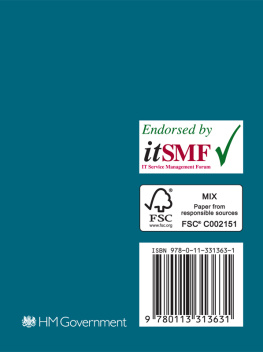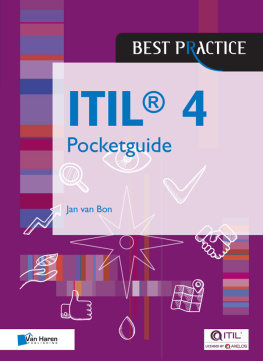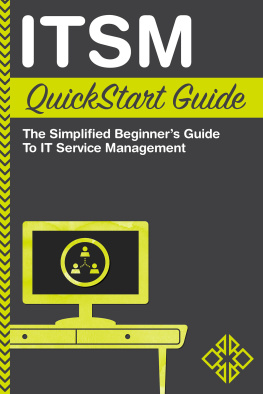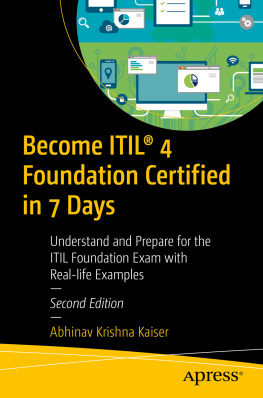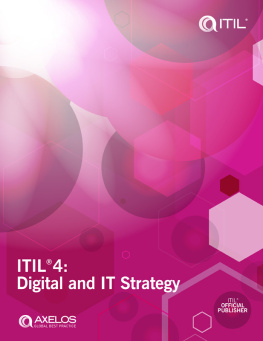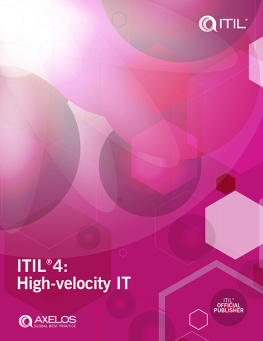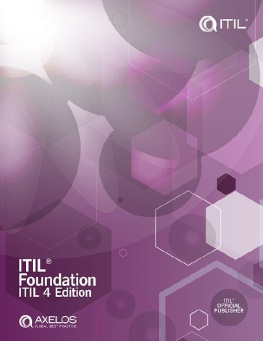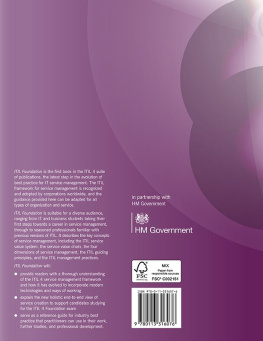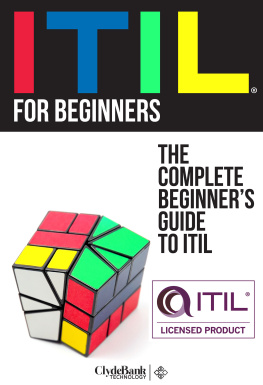
Key Element Guide ITIL Service Operation
London: TSO

Published by TSO (The Stationery Office) and available from:
Online
www.tsoshop.co.uk
Mail, Telephone, Fax & E-mail
TSO
PO Box 29, Norwich, NR3 1GN
Telephone orders/General enquiries: 0870 600 5522
Fax orders: 0870 600 5533
E-mail:
Textphone 0870 240 3701
TSO@Blackwell and other Accredited Agents
Crown copyright 2012
This is a Crown copyright value added product, reuse of which requires a Licence from the Cabinet Office.
Applications to reuse, reproduce or republish material in this publication should be sent to The Efficiency & Reform Group Service Desk, Cabinet Office, Rosebery Court, St Andrews Business Park, Norwich, Norfolk NR7 0HS Tel No: (+44) (0)845 000 4999 E-mail: or complete the application form on the Cabinet Office website, Licensing section.
Copyright in the typographical arrangement and design is vested in The Stationery Office Limited. Applications for reproduction should be made in writing to The Stationery Office Limited, St Crispins, Duke Street, Norwich, NR3 1PD.
The Swirl logo is a trade mark of the Cabinet Office
ITIL is a registered trade mark of the Cabinet Office
P3O is a registered trade mark of the Cabinet Office
MSP is a registered trade mark of the Cabinet Office
PRINCE2 is a registered trade mark of the Cabinet Office
The Best Management Practice Official Publisher logo is a trade mark of the Cabinet Office
OGC (former owner of Best Management Practice) and its functions have moved into the Cabinet Office part of HM Government www.cabinetoffice.gov.uk
Material produced since the move has revised copyright and trademark statements reflecting Cabinet Office ownership.
Best Management Practice guidance that existed at the time of the move will continue to reference OGC until it is updated. Over time all Best Management Practice guidance will be updated and will then fully reflect Cabinet Office ownership and use the updated statements and references where applicable.
If you would like any further advice about our move to Cabinet Office please contact the Efficiency and Reform Group Service Desk, Cabinet Office Tel No: 0845 000 4999, E-mail:
First edition Crown Copyright 2008 Second edition Crown Copyright 2012
First published 2012
ISBN 9780113313631 (Single copy ISBN)
ISBN 9780113313686 (Sold in a pack of 10 copies)
Printed in the United Kingdom for The Stationery Office
Material is FSC certified. Sourced from fully sustainable forests.
P002500757 c18 07/12
Acknowledgements
AUTHOR
Randy Steinberg, Migration Technologies Inc.
KEY ELEMENT GUIDE AUTHORING TEAM
David Cannon, BMC Software
Ashley Hanna, HP
Lou Hunnebeck, Third Sky Inc.
Vernon Lloyd, Fox IT
Stuart Rance, HP
REVIEWERS
Best Management Practice and The Stationery Office would like to thank itSMF International for managing the quality assurance of this publication, and the following reviewers for their contributions:
Duncan Anderson, Global Knowledge; John Donoghue, Allied Irish Bank plc; John Earle, itSMF Ireland Ltd; Robert Falkowitz, Concentric Circle Consulting; Padraig Farrell, SureSkills; Siobhan Flaherty, Generali PanEurope; Signe Marie Hernes Bjerke, Det Norske Veritas; Michael Imhoff Nielsen, IBM; Jackie Manning, Bord Gis Networks; Krikor Maroukian, Kings College London; Reiko Morita, Ability InterBusiness Solutions, Inc.; Trevor Murray, The Grey Matters; Gary ODwyer, Allied Irish Banks plc; Benjamin Orazem, SRC d.o.o.; Sue Shaw, TriCentrica; Marco Smith, iCore Ltd; Hon P Suen, ECT Service Ltd; and Paul Wigzel, Paul Wigzel Training and Consultancy.
1Introduction
This key element guide is intended to provide a summary of the basic concepts and practice elements of ITIL Service Operation, which forms part of the core ITIL publication suite.
ITIL is a set of best-practice publications for IT service management (ITSM). ITIL provides guidance on the provision of quality IT services, and on the capabilities needed to support them. ITIL is not a standard that has to be followed; it is guidance that should be read and understood, and used to create value for the service provider and its customers. Organizations are encouraged to adopt ITIL best practices and to adapt them to work in their specific environments in ways that meet their needs.
ITIL is the most widely recognized framework for ITSM in the world. In the 20 years since it was created, ITIL has evolved and changed its breadth and depth as technologies and business practices have developed.
The section numbering in this key element guide is not the same as the section numbers in the core publication, ITIL Service Operation. Therefore, do not try to use references to section numbers in the core publication when referencing material in this key element guide.
1.1THE ITIL SERVICE LIFECYCLE
The ITIL framework is based on five stages of the service lifecycle as shown in , with a core publication providing best-practice guidance for each stage. This guidance includes principles, processes and activities, organization and roles, technology, challenges, critical success factors, and risks. The service lifecycle uses a hub-and-spoke design, with service strategy at the hub, and service design, service transition and service operation as the revolving lifecycle stages or spokes.
Figure 1.1 The ITIL service lifecycle
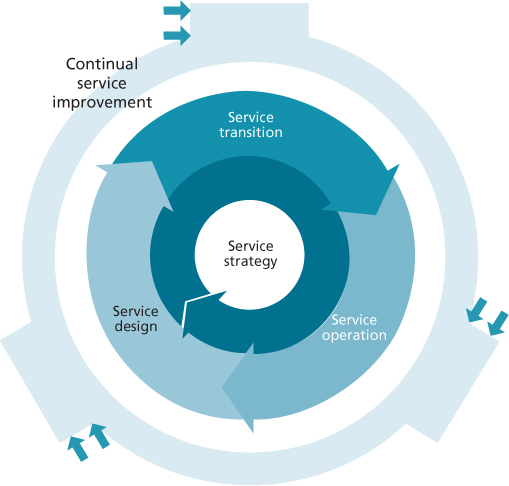
Continual service improvement surrounds and supports all stages of the service lifecycle. Each stage of the lifecycle exerts influence on the others and relies on them for inputs and feedback. In this way, a constant set of checks and balances ensures that as business demand changes, the services can adapt and respond effectively.
In addition to the core publications, there is also a complementary set of ITIL publications providing guidance specific to industry sectors, organization types, operating models and technology architectures.
The following key characteristics of ITIL contribute to its global success:
- Vendor-neutral ITIL service management practices are not based on any particular technology platform or industry type. ITIL is owned by the UK government and is not tied to any commercial proprietary practice or solution.
- Non-prescriptive ITIL offers robust, mature and time-tested practices that have applicability to all types of service organization. It continues to be useful and relevant in public and private sectors, internal and external service providers, small, medium and large enterprises, and within any technical environment.
- Best practice ITIL represents the learning experiences and thought leadership of the worlds best-in-class service providers.
1.2SERVICE OPERATION KEY ELEMENT GUIDE
ITIL Service Operation provides best-practice guidance for the service operation stage of the service lifecycle.
1.2.1Purpose and objectives of service operation
The purpose of service operation is to coordinate and carry out the activities and processes required to deliver and manage services to business users and customers at agreed levels. Service operation is also responsible for the ongoing management of the technology that is used to deliver and support services.
Next page
